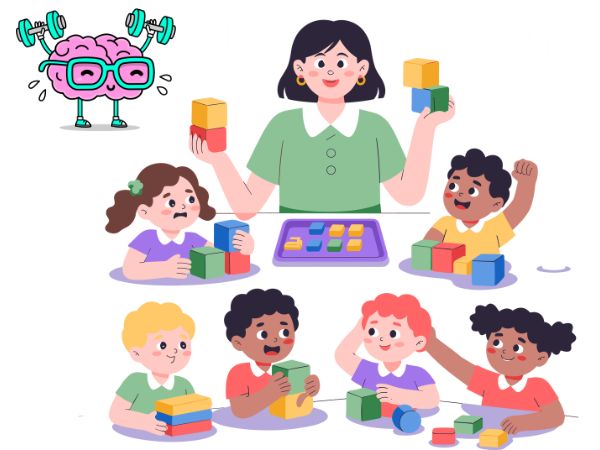The Neuroscience of How Teachers Shape Intelligence
“Every time you teach a child, you help build the brain that will build the future.”
In every classroom — between the quiet concentration of solving a math problem and the lively buzz of a history discussion — something extraordinary is happening.
You’re not just teaching subjects. You’re leading a neural construction project — shaping the physical architecture of your students’ brains.
And now, neuroscience has the blueprints to show just how powerful your work really is.

🧩 The Study That Changed How We See Learning
A groundbreaking study by Wendelken et al. (2017), published in The Journal of Neuroscience, discovered that the way a child’s brain is built determines how well it can think later.
Researchers looked at how two brain regions — the Rostrolateral Prefrontal Cortex (RLPFC) and the Inferior Parietal Lobule (IPL) — work together during reasoning.
They found something remarkable:
Children with stronger structural connectivity (the brain’s wiring) between these regions developed better functional connectivity (communication) — and showed higher reasoning ability as teenagers.
In simple terms:
The roads you help build in a child’s brain today decide how efficiently their thoughts will travel tomorrow.
🏗️ The Brain’s Two Big Building Phases
Think of the brain as a growing city. It develops in two distinct phases:
🧱 Phase 1: The Highway Builders (Ages 6–11)
In this stage, the brain is busy laying down its wiring — Structural Connectivity.
Every story, experiment, and problem a child encounters strengthens these mental “roads.”
Your role here: architect of understanding — every activity you design helps pour the foundation for reasoning and creativity.
🚦 Phase 2: The Traffic Controllers (Ages 12+)
As adolescence begins, the focus shifts to Functional Connectivity — how efficiently ideas flow through those established pathways.
This is where reasoning, innovation, and decision-making truly take shape.
💡 The “Build-Then-Flow” Principle
The study’s insight is simple yet profound:
“RLPFC–IPL structural connectivity in childhood predicted future changes in functional connectivity.”
Translation:
👉 Strong early brain structures lead to smoother, more powerful thinking later.
So, when you teach through exploration, questioning, and creative problem-solving, you’re not just engaging students — you’re building the brain’s future highways of thought.
🧰 Blueprint for Brain-Building Classrooms
Here’s how to apply this neuroscience in Indian classrooms across CBSE, ICSE, and state boards.
🏗️ For the Highway Builders (Ages 6–11): Strengthening Neural Foundations
Goal: Give children rich, hands-on experiences that link ideas and senses.
🕵️♀️ The “What Does It Represent?” Scavenger Hunt
After a Civics lesson on Fundamental Rights, ask:
“If the Right to Equality were a shape, what would it be — and why?”
Or after reading The Thief’s Story (Ruskin Bond), find an object that represents the protagonist’s change of heart.
🧠 Brain Boost: Builds analogical reasoning — linking abstract and concrete ideas.
🕸️ The Story Web
In Glimpses of the Past, students create a web using strings and sticky notes linking characters, causes, and effects.
🧠 Brain Boost: Strengthens structural connections by making cause-and-effect visible and tangible.
🧩 The Secret Pattern Detective
Show the Indian flag, Lotus Temple, and Ashoka Chakra, then ask: “What connects them?”
🧠 Brain Boost: Trains inductive reasoning and pattern detection — the roots of logical thought.
🚦 For the Traffic Controllers (Ages 12+): Developing Complex Reasoning
Goal: Encourage critical thinking, flexibility, and cross-disciplinary connections.
🧠 Debug the Argument
Give students a biased paragraph — e.g., “British rule modernized India.”
Ask them to identify flaws and rewrite it using balanced historical evidence.
🧠 Brain Boost: Strengthens logical reasoning and higher-order analysis.
🔄 Perspective Switch Debate
In a discussion about Portia (The Merchant of Venice) or Ashoka’s policies, ask students to switch sides mid-argument.
🧠 Brain Boost: Builds cognitive flexibility — the neural ability to reframe ideas and adapt.
🎨 Idea Fusion Challenge
Link unlikely topics: “How is photosynthesis like teamwork?” or “What can a Sarojini Naidu poem teach us about energy transfer?”
🧠 Brain Boost: Sparks creative connections — the hallmark of advanced reasoning.
🌱 The Bigger Picture: You’re Building India’s Future
Every “aha!” moment in your classroom sends electrical signals through a child’s brain, strengthening neural pathways that support reasoning, creativity, and empathy.
You may never see the circuits you’re building, but years later — when that student leads a team, solves a problem, or writes something brilliant — your work will echo in their mind’s architecture.
You don’t just teach. You build minds.
And in doing so, you are building the future — one brain at a time.
Source:
Wendelken, C., Ferrer, E., Whitaker, K. J., & Bunge, S. A. (2017). Frontoparietal Structural Connectivity in Childhood Predicts Development of Functional Connectivity and Reasoning Ability. The Journal of Neuroscience, 37(35), 8549–8558.
Want to transform your school too? Bring the power of new-age teaching & learning.
Contact us to revolutionize your school’s teaching approach today!
In service since: 2010.
